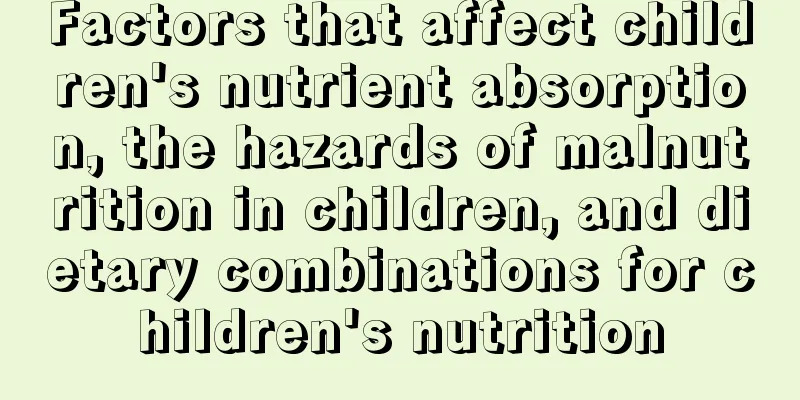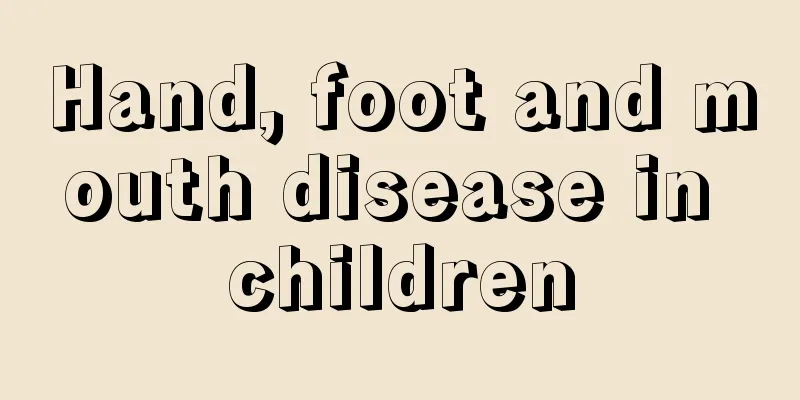Factors that affect children's nutrient absorption, the hazards of malnutrition in children, and dietary combinations for children's nutrition

|
The healthiest growth of children is the greatest wish of parents. However, if parents do not pay attention to guidance on the road of children's growth and development, it is easy for them to go astray. In particular, the living habits of children are very important. If children are unhygienic, prone to partiality and picky eating, it will affect their absorption of nutrition, thereby affecting their growth and brain development. So, what other factors affect children's nutrient absorption? Let's take a look at the detailed introduction below. Factors affecting children's nutrient absorption Children's growth and development need to be achieved through nutrition absorption. If the child refuses to eat and is in a bad mood, it is easy to affect the absorption of nutrition. There are many factors that affect the child's absorption. Parents should pay attention to observation and take precautions. So, what are the factors that affect children's nutrition absorption? In summary, there are mainly the following points: 1. Lead pollution. Wash your hands before eating. If the local area is seriously polluted by lead and you suspect that your child has been exposed to lead, you should see a doctor in time and receive regular treatment. The use of metallothionein (MT) can effectively prevent and treat lead poisoning. 2. Parasites. Parasites can take away the nutrients children need, causing malnutrition. The most important thing to prevent parasites is to pay attention to food hygiene. In normal times, you should wash your hands before meals and after defecation, disinfect tableware regularly, wash and peel fruits and vegetables before eating raw, etc. 3. Partiality and picky eating. Partial and picky eating will prevent children from getting rich and balanced nutrition, causing malnutrition and developmental delay. The way to correct it is the correct guidance of parents. 4. Negative emotions. Because negative emotions can cause gastrointestinal disorders, thereby damaging nutrition. Parents should be careful not to scold their children before or after meals, and create a good emotional atmosphere for meals. 5. Bad living habits. Including irregular living and eating habits, overeating, etc. The key to correction is that first of all, parents should set an example and influence their children with good living habits. Secondly, they should start from the little things in daily life to cultivate good habits for their children, which will benefit their children throughout their lives. The dangers of malnutrition in children 1. In the early stages of malnutrition, height is not affected, but as the condition worsens, bone growth slows down and height is lower than normal. In mild malnutrition, the mental state is normal, but in severe malnutrition, there may be mental depression, poor reaction, low body temperature, weak pulse, loss of appetite, and alternating diarrhea and constipation. When combined with a significant decrease in plasma albumin, there may be pitting edema and shiny skin. In severe cases, the ulcer may rupture and become infected to form a chronic ulcer. Severe malnutrition may cause damage to the functions of important organs. For example, decreased heart function may result in dull heart sounds, low blood pressure, slow pulse, shallow breathing, etc. 2. Since malnourished children have low immune function, they are prone to various infections, such as recurrent respiratory tract infections, thrush, pneumonia, tuberculosis, otitis media, urinary tract infections, etc.; infant diarrhea often persists and aggravates malnutrition, forming a vicious circle. Malnutrition may be complicated by spontaneous hypoglycemia. The child may suddenly show symptoms of pale complexion, confusion, slow pulse, respiratory arrest, no fever but no convulsions. If not diagnosed and treated in time, it may lead to death. Nutritional diet for children The material selection is scientific and targeted. The selection of ingredients for infant food must be based on the criteria of being easy to chew, easy to digest and mild in nature. Babies aged 3-6 have delicate stomachs, so mothers need to cleverly arrange a balanced diet every day. Future Star Children's Growth Milk is a digestive-healthy type that specially adds DHA algae oil + prebiotics to protect children's stomachs, help build a good environment in the body, and promote the absorption of nutrients. The ingredients are cleverly prepared and nutritionally balanced. The 3-6 years old stage is a critical period for the baby's growth and development, and the requirement for nutrients is relatively high. Future Star Little Children's Growth Milk is nutritionally balanced and specially developed for babies aged 3-6 years old. It is rich in 50 kinds of dietary nutritional essences and specially added with DHA algae oil and high-quality prebiotics - oligosaccharides to help babies get balanced nutrition. 1. Scientific combination of staple and side dishes, and between meat and vegetables; 2. Color matching. Dishes such as colorful shrimps and colored tofu can stimulate children's appetite through beautiful colors. 3. The cutting is reasonable and the knife skills are practical. 4. The taste is mild and can be cooked in a variety of ways. 5. Cook one dish in multiple ways and keep it fresh and innovative. 6. Keep clean and hygienic, avoid pollution. Young children have poor immunity and weak resistance, so safety and hygiene should be put first when cooking. For example, cooked meat must be steamed before eating, seasonal vegetables should not be eaten raw, and the operation room and cooking utensils should be disinfected and cleaned in a timely manner. It can be seen that there are many factors that affect children's nutrient absorption. If a child is malnourished, it will be very harmful to the child, especially in the initial years of the child's development. Parents must spend more time and effort to cultivate their children's living habits. They must not be careless and leave the children to the elderly or entrust the children to other people to take care of them, regardless of the child's diet and daily life. |
<<: Children's massage methods
>>: The relationship between children's "three measurements" and physical health
Recommend
Treatment of Scoliosis in Children
Scoliosis in children is a relatively serious dis...
What to do if baby has eye mucus in the corner of the eye
One thing that parents are very concerned about i...
What causes intestinal effusion in children?
Most of the time, intestinal effusion in babies i...
What causes acrodermatitis in children?
Sometimes, some small red spots appear on childre...
What medicine should children take for allergic asthma
The physical health of children is the most impor...
Can my baby get a vaccination if he has phlegm in his throat?
Because newborn babies have relatively weak body ...
Can children brush their teeth after losing their teeth?
Children generally need to go through the process...
What to do if your baby lacks vitamins
Vitamins are an important nutrient in the human b...
How to treat drooling in children with cerebral palsy
If a child with cerebral palsy drools, parents wi...
What to do if a girl's nipple has a hard core
Some parents feel a little panicked when they fin...
6 tips to help you raise a child with money
After having children, many mothers cut down on t...
Ways to improve your child's memory
Improving children's memory is the hope of pa...
Baby high fever convulsions
If a baby has a high fever and is accompanied by ...
8 month old baby shaking his head
For mothers, they will notice any behavior of the...
Why does my baby have to strain to urinate?
Many mothers judge the baby's physical health...









